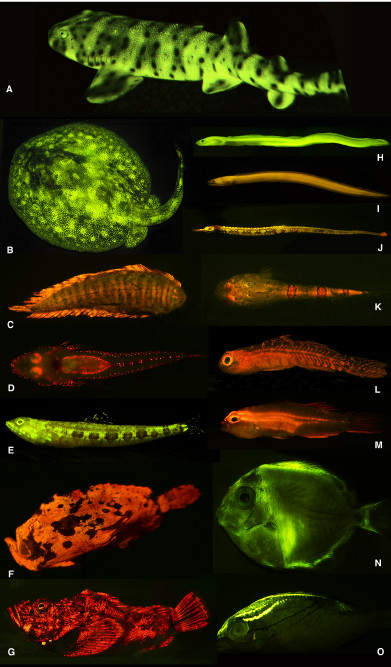
Various fluorescent fishes. Credit: Sparks et al 2014
In the ocean, longer wavelengths of light (i.e. red) are quickly filtered out, so that with increasing depth the red pigmentation of marine life takes on increasingly inky tones. This provides excellent camouflage in the darkness and is why so many deeper-water creatures sport such vividly carmine hues. There are, however, fishes from these depths that can appear red even in the absence of ambient red light. They do so by absorbing the high-energy blue light which surrounds them and emitting a lower-energy red light, a process known as fluorescence. That reef fish were capable of this was entirely unknown until it was first documented in 2008, and now some newly published research is helping to shed light (pun!) on this poorly understood phenomenon.
The source of the fluorescence are concentrations of guanine crystals contained within highly branched cells called iridophores. Through various histological and biophysical methodologies, it has been determined that at least some of the reef fishes emitting this red light are indeed able to detect it and even to behaviorally control its intensity—this implies that this red fluorescence is not merely some biochemical accident but, rather, an important part of how these species communicate with each other. Research conducted on Eviota gobies has shown that these fluorescent iridophores are capable of expanding and contracting in response to certain neurotransmitters and hormones, resulting in a dimming and brightening of the fluorescent light. For a cryptic goby like this, is this red coloration used for camouflage or for intraspecific communications?
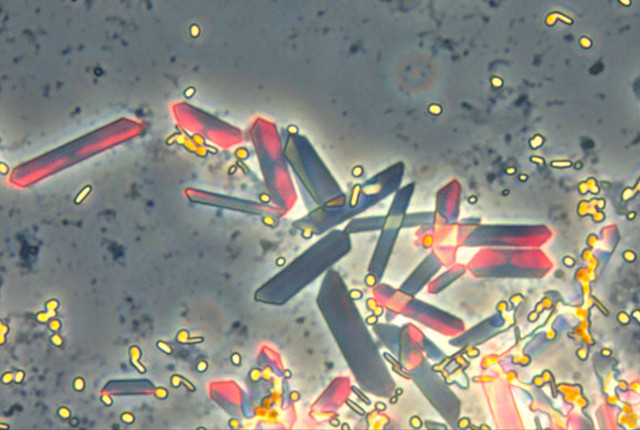
Red fluorescent guanine crystals. Note that many fishes have non-fluorescent guanine crystals that impart a blue or silver hue instead. Credit: Michiels et al 2008

The contractile capabilities of a fluorescent iridophore in Eviota. Credit: Wucherer & Michiels 2012
Another group that appears to rely heavily on red fluorescence are the wrasses of the Tribe Pseudocheilini, which includes such familiar aquarium fishes as the Fairy Wrasses (Cirrhilabrus), Flasherwrasses (Paracheilinus), and the Sixline, Eightline and Mystery Wrasses of Pseudochelinus. Most species in this group occur in moderate depths (usually below 10 meters) where red ambient light is lacking, and the entire tribe is morphologically identifiable from a distinctive “double lens” in the cornea which acts as a “yellow intraocular filter”, enabling them to visualize longer wavelengths of light.
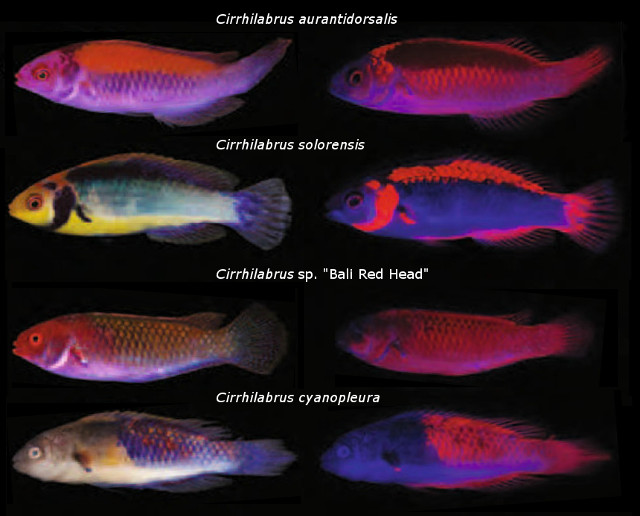
Fluorescence in the Cirrhilabrus cyanopleura species group. Note that Cirrhilabrus sp. “Bali Red Head” shows a similar pattern ventrally as C. aurantidorsalis, arguing against this form being either the female of C. solorensis or a variant of C. cyanopleura as suggested by some sources. Credit: modified from Gerlach et al 2016
Unlike with many of the other fluorescent fishes so far known, there is a clearer indication of what role this fluorescence serves in these wrasses, as (for the species studied thus far) it is generally the males alone which possess this ability. Recall that for Cirrhilabrus and Paracheilinus, males are always considerably different in coloration from females and engage in a haremic social structure wherein a male maintains a territory to attract females. Research conducted on the Solor Fairy Wrasse (C. solorensis) illustrated the importance of this coloration nicely, as, by using filters and mirrors to limit the ability of a specimen to see its reflection, antagonistic behaviors could be reliably controlled. Such species-specific fluorescent colors are also likely to help in species recognition, as many of these fishes occur in dense, multi-species shoals.
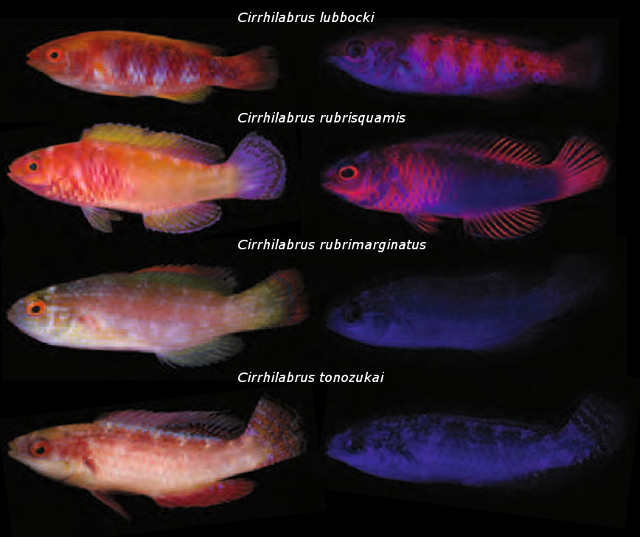
Fluorescent patterns in the short-finned (lubbocki & rubrisquamis) and long-finned (rubrimarginatus & tonozukai) clades of Cirrhilabrus. Credit: modified from Gerlach et al 2016
The recently published research of Gerlach et al adds further details to this, showing that the intensity and wavelength of the emitted light varies from species to species. In some (e.g. Cirrhilabrus solorensis), there is a particularly strong fluorescence, while others (Cirrhilabrus rubrimarginatus) show minimal emittance. The intensity appears to correlate strongly with a phylogeny for this genus that I have previously proposed, as the strongest fluorescence is found in a large clade possessing short pelvic fins, while another major clade defined by longer pelvic fins (C. rubrimarginatus & C. tonozukai in this study) shows little red. The likely explanation for this has to do with a specialization seen in the caudal fin of this long-finned clade, which creates a shimmering reflectance that presumably obviates the need for any fluorescence in intraspecies communications.
Likewise, those species lacking a reflective tail show the greatest fluorescent ability, particularly so with the C. cyanopleura species group, whose members are somewhat unique in the genus for seemingly lacking an obvious nuptial display. Knowing that at least four members of this group—and likely C. luteovittatus, randalli, & cf aurantidorsalis as well—are capable of emitting a strong, species-specific red fluorescent patterning, we can hypothesize that the absence of a “flashing” nuptial display has been filled by the presence of a fluorescent display instead.
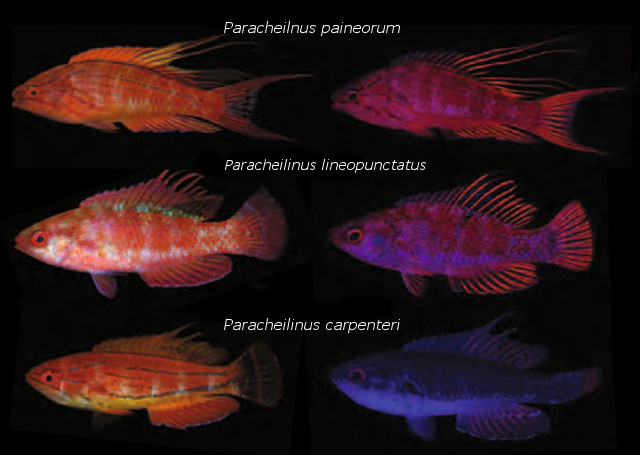
Fluorescent patterns in Paracheilinus. Credit: modified from Gerlach et al 2016
A similar situation may exist amongst the flasherwrasses, though only three species have been studied to date. Of these, P. carpenteri displays minimal fluorescence, while P. lineopunctatus and P. paineorum have an evenly dispersed glow across their fins and body. It’s interesting to note that these latter two species appear almost identical in their fluorescent patterning, which calls into question the importance of this trait when it comes to interspecies communications amongst Paracheilinus, though this might be explained by the differences in their caudal fin shape. An informative example might come from examining the patterns of fluorescence seen in the many related forms that coöccur in West Papua—P. paineorum, P. cyaneus, P. waltoni, P. nursalim.
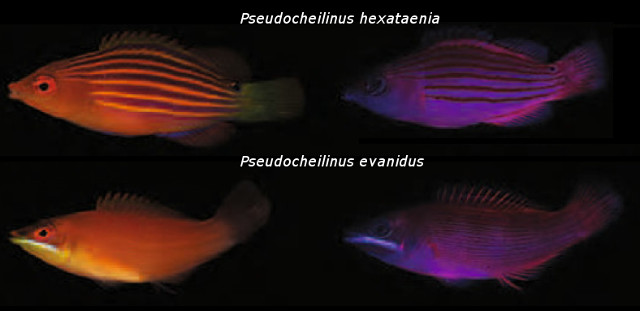
Fluorescent patterns in Pseudocheilinus. Credit: modified from Gerlach et al 2016
There is undoubtedly a great deal to be learned from studying the fluorescence of these wrasses, particularly when it comes to the nitty gritty of determining species boundaries and understanding their evolutionary relationships. Aquarists are in a unique position to help in this regard, as all that is required to document these patterns is a source of blue (=actinic) light in the aquarium and a camera equipped with a red filter. Many rare species of Cirrhilabrus find their way into reef aquaria, and, as these often engage regularly in their nuptial displays, such captive specimens afford a fantastic opportunity to capture these behaviors on video in their full fluorescent splendor.









The stars here are the various invertebrates which call the reef home. There are no cliched scenes of shark feeding frenzies or clownfishes swimming among anemone tentacles.
No offense but your avatar reminds me about Sheldon Cooper, Mr. Rowlett